
Vienna is the capital, largest city, and one of nine federal states of Austria. Vienna is Austria's most populous city and its primate city, with about two million inhabitants, and its cultural, economic, and political center. It is the fifth-largest city proper by population in the European Union and the largest of all cities on the Danube river by population.
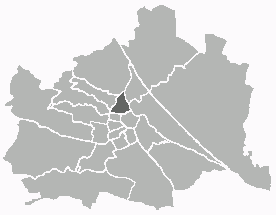
Alsergrund is the ninth district of Vienna, Austria. It is located just north of the first, central district, Innere Stadt. Alsergrund was incorporated in 1862, with seven suburbs. As a central district, the area is densely populated. According to the census of 2001, there were 37,816 inhabitants over 2.99 square km.

Simmering is the 11th district of Vienna, Austria. It borders the Danube and was established as a district in 1892. Simmering has several churches, some museums, schools, old castles, and four cemeteries, one of them being the Wiener Zentralfriedhof, one of the largest cemeteries of Europe.

Leopoldstadt is the 2nd municipal district of Vienna in Austria. As of 1 January 2016, there are 103,233 inhabitants over 19.27 km2 (7 sq mi). It is situated in the heart of the city and, together with Brigittenau, forms a large island surrounded by the Danube Canal and, to the north, the Danube. It is named after Leopold I, Holy Roman Emperor. Due to its relatively high percentage of Jewish inhabitants before the Holocaust, Leopoldstadt gained the nickname Mazzesinsel. This context was a significant aspect for the district twinning with the New York City borough Brooklyn in 2007.

Landstraße is the 3rd municipal district of Vienna, Austria. It is near the center of Vienna and was established in the 19th century. Landstraße is a heavily populated urban area with many workers and residential homes. It has 89,834 inhabitants in an area of 7.42 km2. It has existed since about 1200 AD. In 1192, the English king Richard the Lionheart was captured in the Erdberg neighbourhood, after the unsuccessful Third Crusade.
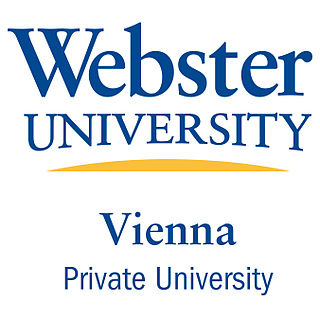
Webster Vienna Private University is a private American university in Vienna, Austria. While affiliated to the Webster University in St. Louis, USA, it remains a distinct and separate institution.
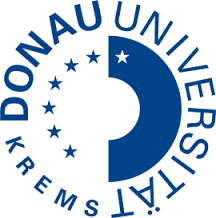
The University for Continuing Education Krems is an Austrian university specializing in further education for working professionals. It is located in Krems an der Donau, Lower Austria.
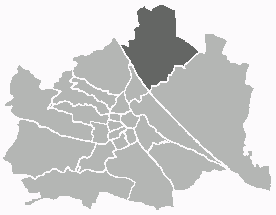
Floridsdorf is the 21st district of Vienna, located in the northern part of the city and comprising seven formerly independent communities: Floridsdorf, Donaufeld, Greater Jedlersdorf, Jedlesee, Leopoldau, Stammersdorf, and Strebersdorf.

The Donauinsel is a long, narrow artificial island in central Vienna, Austria, lying between the Danube river and the parallel excavated channel Neue Donau. The island is 21.1 km (13.1 mi) in length, but is only 70–210 m (230–689 ft) wide. It was constructed from 1972 to 1988 primarily as a measure for flood protection.
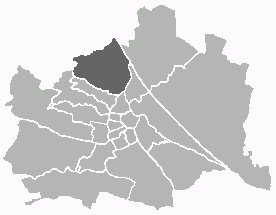
Döbling is the 19th district in the city of Vienna, Austria. It is located in the north of Vienna, north of the districts Alsergrund and Währing. Döbling has some heavily populated urban areas with many residential buildings, and borders the Vienna Woods. It includes some of the most expensive residential areas such as Grinzing, Sievering, and Neustift am Walde, and is home to many Heurigen taverns. There are some large Gemeindebauten, including Vienna's most famous, the Karl-Marx-Hof.

Donaustadt is the 22nd district of Vienna, Austria . Donaustadt is the eastern district of Vienna.
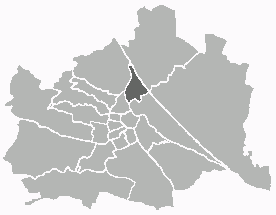
Brigittenau is the 20th district of Vienna. It is located north of the central districts, north of Leopoldstadt on the same island area between the Danube and the Danube Canal. Brigittenau is a heavily populated urban area with many residential buildings.

Heiligenstadt was an independent municipality until 1892 and is today a part of Döbling, the 19th district of Vienna, Austria.

The Donaukanal is a former arm of the river Danube, now regulated as a water channel, within the city of Vienna, Austria. It is 17.3 kilometres (10.7 mi) long and, unlike the Danube itself, it borders Vienna's city centre, Innere Stadt, where the Wien River (Wienfluss) flows into it.

Donau City, or Vienna DC, is a new part of Vienna's 22nd District Donaustadt, next to both the Reichsbrücke and the left bank of the Danube's 21.1 km new channel, Neue Donau.

The Danube is the second-longest river in Europe, after the Volga in Russia. It flows through much of Central and Southeastern Europe, from the Black Forest south into the Black Sea. A large and historically important river, it was once a frontier of the Roman Empire. In the 21st century, it connects ten European countries, running through their territories or marking a border. Originating in Germany, the Danube flows southeast for 2,850 km (1,770 mi), passing through or bordering Austria, Slovakia, Hungary, Croatia, Serbia, Romania, Bulgaria, Moldova, and Ukraine. Among the many cities on the river are four national capitals: Vienna, Bratislava, Budapest, and Belgrade. Its drainage basin amounts to 817,000 km² and extends into nine more countries.

The New Danube is a side channel built in 1972–88 on the eastern side of the Danube in Vienna, Austria. It was created to provide flood relief by containing excess water. The Donauinsel, made out of the removed material, separates the new waterway from the main channel of the river. The project was referred to by the United Nations Human Settlements Programme (UN-HABITAT) as "the first truly multipurpose fully sustainable flood protection scheme."

The Vienna University of Economics and Business is a public research university in Vienna, Austria. The university received Triple accreditation.
The Vienna School of Osteopathy (WSO) is a private educational institution in Austria specialising in osteopathy. Extra occupational and postgraduate trainings are offered for physiotherapists and doctors of medicine. University programmes are also open for graduates from other osteopathy schools. Up to now 550 students finished their training and currently 350 students are enrolled in training groups. Established in 1991, the WSO was the first provider of osteopathic training at academic level in Austria. It is located in Vienna, Hietzing at Frimbergergasse 6.

District Museum Brigittenau is a local museum in Brigittenau a district of Vienna, Austria / EU. It is located at the address Dresdner Straße 79.



















